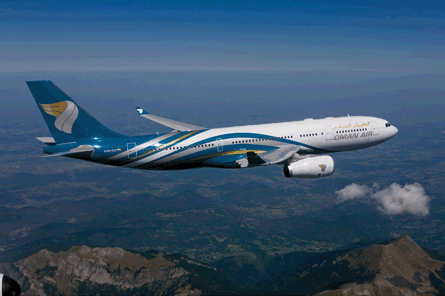For Oman Air, the past 12 months has been one of frantic expansion as it transitioned from a regional player to fully fledged international airline with a network to match.
"It's been non-stop," says chief executive Peter Hill. "A year ago we were still trying to shake off the regional airline image, but then we started putting the Airbus A330 widebodies into service in winter 2009."
Until 2007, Oman Air had operated in the shadow of Gulf Air in which the Omani government held a 50% stake with fellow shareholder Bahrain. However, this changed when the government decided to sell out to Bahrain and throw its lot in with Oman Air, which until then had been a majority privately owned carrier. Hill, a former boss of Sri Lankan Airlines who has also held executive positions with Emirates and Gulf Air, was appointed to oversee the airline's transition two years ago.
 |
|---|
© Oman Air |
"Before the A330s arrived, we were known as a regional airline based in Muscat with a couple of long-haul services to London and Bangkok with other people's leased aeroplanes," says Hill.
NEW DESTINATIONS
To underwrite the government's aim to put Oman Air on the map as an international carrier, since September 2009 it has added six A330s and new destinations in Europe and Asia. Five Boeing 737s have been delivered in the past 18 months, taking its fleet of the twinjet to 15 aircraft.
There has also been a drive to reorganise schedules, service product and image, says Hill. "At the end of last year, we had two long-haul destinations - London and Bangkok. Now we're up to four in Europe, with a fifth - Milan - starting by year-end."
The airline has also boosted its short-haul and regional network, including the addition of secondary points in the Gulf.
Oman Air has also been pioneering products, with its A330s becoming in March the first in the world to offer passengers full in-flight connectivity for mobiles and internet through the Airbus/Sita joint venture OnAir.
The airline's effort to reinvent itself has been rewarded by an impressive surge in seat factor and traffic. During the first half of 2010 Oman Air has seen a 40% increase in available seat-kilometres, a 73% rise in revenue passenger-kilometres and a 14 point improvement in seat factor, over the same period last year. "Our passenger numbers are up 46% and cargo 44%," says Hill.
The success of the airline's expanding long-haul network has seen a ballooning in the level of lower-yield transit traffic routeing through its Muscat hub, which has risen from a share of around 30% a year ago to 50-55%, says Hill.
"We need to work harder with our tourist board in publicising Oman as a tourism destination. Unlike our bigger cousins up the Gulf, Oman Air's primary focus is on point-to-point traffic. A lot of our services are built to encourage more travel into and out of Oman. Our hub comes into its own as a secondary generator of traffic."
Hill acknowledges that the Oman Air is carrying "more passengers through our hub than we would like to", but he sees this as a short-term measure. "Connecting traffic means low yields, and our future is higher yields on point-to-point."
Work is under way to attract this business through better schedules, and this effort will be augmented in summer 2011, when the first two of four - and potentially up to nine - Embraer 175s are introduced on regional services. This will enable better matching of aircraft capacity to the route, as well as increased frequencies and in some cases the replacement of "triangular" services with direct flights, says Hill.
Oman Air has one more A330 due in 2011 and then a couple of years of consolidation until 2014, when the first of six more 737s are due as well as the initial batch of Boeing 787s. By this time Hill expects the airline group will be profitable. It lost 64.3 million Rials ($167 million) in 2009 and should break even in 2013.
Hill says the airline may add A330s ahead of the Dreamliner introduction if the board approves further long-haul network development in 2012-13. "We'll probably wait to see the results of this year before deciding whether we want more expansion before the 787s arrive."
Source: Flight International























